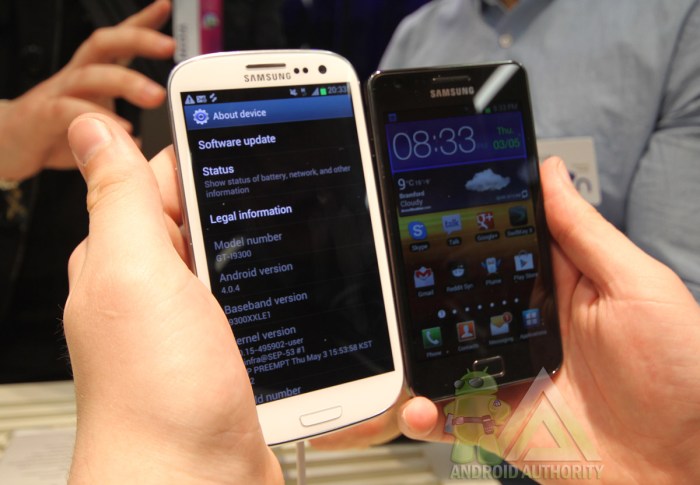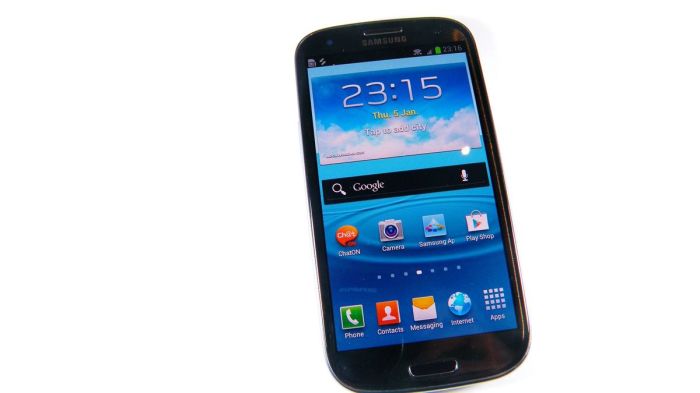Samsung Galaxy S3 Full Specification
Samsung Galaxy S3: A Deep Dive into its Specifications and Legacy: Samsung Galaxy S3 Full Specification

Source: androidauthority.com
Samsung galaxy s3 full specification – Released in 2012, the Samsung Galaxy S3 quickly became a flagship device, solidifying Samsung’s position as a leading smartphone manufacturer. Its sleek design, powerful specifications for its time, and innovative features captivated consumers globally. This article delves into the technical details, design elements, and lasting impact of this iconic device.
Device Overview
The Samsung Galaxy S3 launched in May 2012, succeeding the Galaxy S2 and setting the stage for the Galaxy S4. Its initial marketing emphasized a user-friendly experience, powerful performance, and a visually appealing design, targeting a broad audience of tech-savvy consumers and those upgrading from older devices. Key design elements included a smooth, rounded unibody construction, primarily made of plastic, and a large, vibrant Super AMOLED display.
The device was available in various colors, contributing to its appeal.
Understanding the Samsung Galaxy S3 full specification requires considering its technological context. A significant leap forward was seen with its successor, and to fully appreciate the S3’s limitations, comparing it to the advancements in the samsung galaxy s9 specification is beneficial. This comparison highlights the rapid evolution of Samsung’s flagship devices and provides a clearer picture of the S3’s capabilities within its generation.
| Feature | Galaxy S2 | Galaxy S3 | Galaxy S4 |
|---|---|---|---|
| Screen Size | 4.3 inches | 4.8 inches | 5.0 inches |
| Body Material | Plastic | Plastic | Plastic |
| Design Aesthetics | Sleek, but less rounded | Smooth, rounded unibody | More refined, slightly curved |
| Build Quality | Solid, but showed some wear | Generally durable, prone to scratches | Improved durability and feel |
Technical Specifications, Samsung galaxy s3 full specification
The Galaxy S3 boasted impressive specifications for its time. The internal hardware significantly improved upon its predecessor, providing a smoother and more responsive user experience.
| Specification | Value | Unit | Notes |
|---|---|---|---|
| Processor | Exynos 4 Quad or Qualcomm Snapdragon S4 | – | Varied by region |
| Clock Speed | 1.4 GHz – 1.5 GHz | GHz | Depended on the processor variant |
| RAM | 1 GB | GB | Standard across all variants |
| Storage | 16 GB, 32 GB, 64 GB | GB | Multiple options available |
| Screen Resolution | 1280 x 720 | pixels | HD display |
| Screen Technology | Super AMOLED | – | Known for vibrant colors and deep blacks |
Camera Capabilities
The Galaxy S3 featured a significant camera upgrade compared to its predecessor. While not the highest megapixel count available at the time, the camera’s performance was generally well-regarded for its image quality and video capabilities.
The primary camera boasted an 8-megapixel sensor with autofocus and LED flash. It could record 1080p Full HD video at 30 frames per second.
- Similarities to contemporaries: Many phones around the same time also featured 8MP sensors and 1080p video recording.
- Differences from contemporaries: The Galaxy S3’s image processing and software features, like its various shooting modes, often provided a more user-friendly and polished experience compared to some competitors.
Software and Features

Source: co.uk
The Galaxy S3 launched with Android 4.0 (Ice Cream Sandwich) and later received updates to Android 4.1 (Jelly Bean) and 4.3 (Jelly Bean). Samsung’s TouchWiz UI overlay provided a distinct user experience with customized features and pre-installed applications.
The user experience was generally considered smooth and intuitive, despite the sometimes criticized bloatware. The large screen and responsive touch interface made navigation and multitasking fairly easy.
Connectivity and Sensors

Source: futurecdn.net
The Galaxy S3 offered a range of connectivity options, typical for a flagship device of its era. It also incorporated several sensors to enhance its functionality and user experience.
- Network Technologies: 3G, HSPA+, LTE (variant dependent)
- Connectivity: Wi-Fi 802.11 a/b/g/n, Bluetooth 4.0, NFC
- Sensors: Accelerometer, proximity sensor, ambient light sensor, compass, gyroscope
Battery and Performance
The Galaxy S3’s battery life and overall performance were considered adequate for its time, though not exceptional by modern standards. Its performance was comparable to other high-end smartphones of 2012.
| Feature | Galaxy S2 | Galaxy S3 | Galaxy S4 |
|---|---|---|---|
| Battery Capacity | 1650 mAh | 2100 mAh | 2600 mAh |
| Processor Performance | Lower | Medium | Higher |
| Screen Resolution | Lower | Medium | Higher |
Legacy and Impact
The Samsung Galaxy S3 was a commercial success, selling tens of millions of units worldwide. Its popularity significantly contributed to Samsung’s rise as a dominant player in the mobile phone market. The device’s influence on the industry is considerable.
- Popularized large-screen smartphones: Its 4.8-inch display was larger than many competitors at the time, influencing a trend towards larger screens.
- Advanced camera features: While not revolutionary, its camera capabilities were highly competitive and helped set a standard for smartphone photography.
- Improved user interface: TouchWiz continued to evolve, influencing subsequent Samsung UI designs.
FAQ Overview
Was the Samsung Galaxy S3 waterproof?
No, the Samsung Galaxy S3 was not waterproof.
Did the Galaxy S3 have expandable storage?
Yes, it offered expandable storage via microSD card.
What wireless charging capabilities did the S3 possess?
The Galaxy S3 did not have wireless charging capabilities.
What was the typical price at launch?
The launch price varied by region and carrier but was generally in the high-end smartphone price range for its time.





















